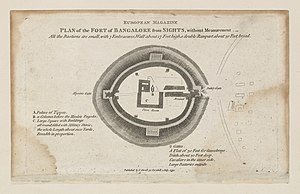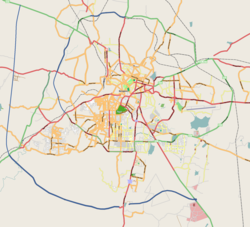Bangalore Fort
| Bangalore Fort | |
|---|---|
| Part of Bangalore District | |
| Karnataka, India | |

Bangalore Fort
|
|

Plan of Bangalore Fort, 1792
|
|
| Coordinates | 12°57′46″N 77°34′33″E / 12.962875°N 77.575956°E |
| Type | Fort |
| Site information | |
| Controlled by | Archaeological Survey of India |
| Open to the public |
Yes |
| Condition | Fair |
| Site history | |
| Built | 1537 |
| Built by | Kempegowda I |
| Materials | Initially built in 1537 in mud but later renovated in 1751 with granite stones |
Bangalore Fort began in 1537 as a mud fort. The builder was Kempe Gowda I, a vassal of the Vijaynagar Empire and the founder of Bangalore, now Bengaluru. Haider Ali in 1761 replaced the mud fort with a stone fort. The army of the British East India Company, led by Lord Cornwallis on 21 March 1791 captured the fort in the siege of Bangalore during the Third Mysore War (1790–1792). At the time the fort was a stronghold for Tipu Sultan. Today, the fort's Delhi gate, on Krishnarajendra Road, and two bastions are the primary remains of the fort. A marble plaque commemorates the spot where the British breached fort's wall, leading to its capture. The old fort area also includes Tipu Sultan's Summer Palace, and his armoury. The fort has provided the setting for the treasure hunt in the book Riddle of the Seventh Stone.
The confirmed history of the Bangalore Fort is traced to 1537, when Kempe Gowda I (pictured), a chieftain of the Vijayanagara Empire, widely held as the founder of modern Bangalore, built a mud fort and established the area around it as Bengaluru Pete, his capital.
Kempe Gowda I, who showed remarkable qualities of leadership from childhood, had a grand vision to build a new city which was further fueled by his visits to Hampi, now a UNESCO heritage city, the then beautiful capital city of the Vijayanagar Empire. He persevered with his vision and got permission from the King Achutaraya, the ruler of the empire, to build a new city for himself. The King gifted 12 hoblis (revenue subdivisions) with an annual income of 30,000 varahas (gold coins) to Kempe Gowda to meet the expenses of his venture of building a new city.
...
Wikipedia

